Transition Bath’s energy group would like to congratulate one of our volunteers, Sarah Warren on becoming a CAT (Centre for Alternative Technology) student, studying for an MSc in Sustainability and Adaptation .
As part of her application process she wrote this article on thermal imaging based on her experiences with the Bathford Energy Group and Transition Bath. It gives you a flavour of the work we have been doing with our thermal imaging camera over the last 3 years:
Does my home leak heat?
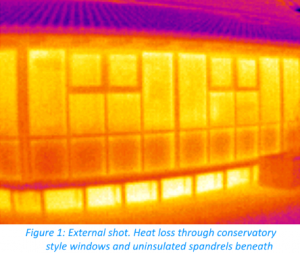
Where does your home leak heat? For the last three winters, Transition Bath has been running a volunteer-led thermal imaging initiative, which gives householders pointers to the areas in which their homes are losing heat in winter, and advice about how to reduce energy consumption. In addition to surveys of domestic properties the group’s thermal imaging camera has also been used to improve yields at a subterranean mushroom farm, reduce energy consumption at a museum, identify heat loss in schools, and teach children about heat loss and insulation.
In infrared thermography (or thermal imaging), a camera is used to measure the radiant heat emitted from a surface, and converts the resultant signal to a two-, or even three1-dimensional image. Colours are used to make gradations in the temperature of the surface visible to the human eye. (Figure 1)
The technique has been used in building diagnostics since the 1970’s2 to produce a qualitative picture of the thermal conductivity of a building (as discussed in more detail by Martin Holladay in his blog for Green Building Advisor). Device size and price have both decreased until today, cameras are within reach of community groups and small businesses. Surveys are routinely carried out to identify areas of heat loss, roof leaks, and water ingress into buildings3, 4.
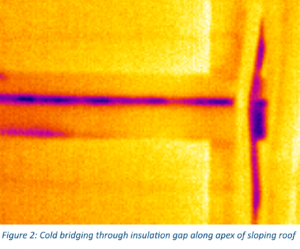
Where volunteers carry out surveys, there are a number of important considerations. Volunteers undergo training in topics including: use of the camera; issues most likely to be observed; and relevant measures to be taken to counter these.
Weather is another consideration. Surveys are better carried out after dark, when the difference between internal and external temperature is 15⁰C or more; for external shots you need calm, dry conditions. In Britain, this restricts us to colder evenings in winter.
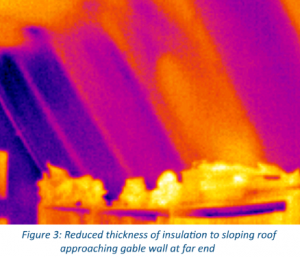
One of the problems most frequently highlighted in surveys is cold bridging (Figure 2) – which occurs where there is a break in the continuity, or a penetration of, the insulation, at junctions such as window frames, and between walls and floors. Others include missing or patchy insulation (Figure 3), draughts (Figure 4), and conduction from behind radiators (Figure 5).
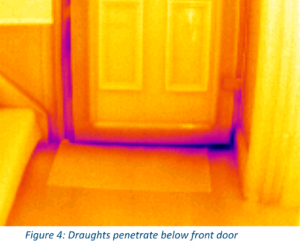
Evidence exists to suggest that giving householders thermal images increases motivation to tackle problem areas through which their house is losing heat5. Our experience is that householders typically find images of their home fascinating. Our plan in future is to carry out follow-up questionnaires, perhaps a year after the survey, to identify actions taken in response, and whether the research findings are borne out in practice.
We are also considering our pricing model. The first year, the surveys were offered free of charge. Subsequently, customers were asked to pay, in part to cover insurance costs,
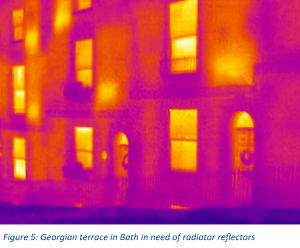
and partly because we felt that surveys might be more highly-valued (and consequently more likely to engender action) if they cost money. Discussion continues around the right price, and the relative value of a survey completed by volunteers, as compared to a professional (for which the going rate is around £200 for a full survey with report). An indicative price of £40 was suggested by Transition Bath in 2015, but it was left to volunteers to decide how to broach this figure with customers.
Approaches to publicity are similarly under discussion. We have tried leafleting house to house to attract interest, but even leaflets targeted at the surveyor’s neighbours, and including the surveyor’s name, address and phone number, have been found largely unsuccessful.
Our surveys have typically included a full report containing images and recommendations, and volunteers have found this an interesting, but quite onerous task, requiring an hour for the visit to the property, and 3 hours or so to write up. Customers, on the other hand, have seemed delighted. The group is considering a tiered pricing model for the future, with perhaps a full report for a higher price, a series of images alone for an intermediate price, and an external view of the front façade of the property for free. Discussion is continuing as to whether full, or indeed any significant benefit will be gained by the occupier from images in the absence of a report. An alternative model might be pricing according to house size.
The volunteers have found it great fun visiting houses, making new acquaintances amongst their neighbours, and testing their skills at spotting leaks; and many of the building occupants have made significant energy savings as a result. However, our marketing model requires some refinement, in order to establish optimum methods of publicity, and to ensure the maximum use is made of the camera during the short winter season; as does our pricing structure, in order to ensure fairness to customer, to surveyor and to Transition Bath itself.
Feedback from readers with relevant experience of similar community schemes is welcome. Please e-mail us at thermalimaging@transitionbath.org
Figures 1-4: Sarah Warren; Figure 5: courtesy of Transition Bath
References
1 Wang, C.; Cho, Y.; Gai, M. J. Comput. Civ. Eng., 27(6), 2013, 645–656 http://ascelibrary.org/doi/abs/10.1061/(ASCE)CP.1943-5487.0000273
2 Tobiasson, W.; Korhonen, C.; Van den Berg, A.; “Hand-held Infrared Systems for Detecting Roof Moisture”, From the NRCA / NBS Proceedings of the Symposium on Roofing Technology, Sept 1977 http://docserver.nrca.net/pdfs/technical/268.pdf
3 Balaras, C.A.; Argiriou A.A. Energy and Buildings, 34(2), 2002, 171–183 http://dx.doi.org/10.1016/S0378-7788(01)00105-0
4 Lo, T.Y.; Choi K.T.W. Structural Survey, 22(5), 2004, 259-263 http://dx.doi.org/10.1108/02630800410571571
5 Goodhew, J.; Pahl, S.; Auburn, T.; Goodhew, S. Environment & Behavior, Sept 9th, 2014, 1-30 http://dx.doi.org/ 10.1177/0013916514546218